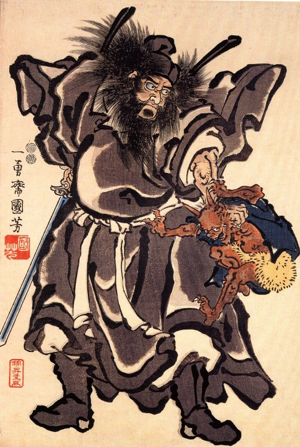We are now sufficiently conditioned to automatically add one year whenever we find in older literature that Kunisada died in 1864. Indeed, he died on the 15th day of the Twelfth month of Genji 1 (1864), which corresponds with January 12th 1865 in our Gregorian calendar. Consequently, his dates are 1786-1865. We probably also know by now that Katsukawa Shunshō died in 1793, on January 19th, the date corresponding with the 8th day of the Twelfth month of Kansei 4 (1792) in the Japanese lunar calendar.
When I was recently working on my forthcoming monograph on Kuniyoshi, and worked out what would be the equivalent of the 15th day of the 11th Month of Kansei 9 (1797), the date of his birth, the outcome was January 1st, 1798. As I then checked how many times I myself had simply not gone to the trouble to check this in past publications, I was shocked, especially as I had already in 1988 worked out the correct date, but apparently forgot since.
However, in counting Kuniyoshi’s age, we will have to stick to the circumstance that he was born in Kansei 9 (1797) and then considered to be one year old, turning 2 just a month and a half later at the New Year of Kansei 10 (1798). Consequently, the drawing of Shōki that he would make ‘at the age of twelve’ was made in 1808, whereas we would only consider him twelve in the year 1809.

Then I decided to make a note in the margin of my copy of Roberts’ Dictionary of Japanese Artists so I will never make this mistake again, especially when I am again too lazy to check this properly, and I can advise everybody to do the same. And now that you start doing this, you may also want to add the correct dates for:
Kita Busei 喜多武清 (1776-1857) as he died on 1856-XII-20, or our January 15th, 1857; Akatsuki Kanenari 暁鐘成 (1793-1861) as he died on 1860-XII-19, or our January 29th, 1861; Ichikawa Kansai 市川甘齋 (died 1836), that is 1835-XII, our 1836-I or II; Torii Kiyomine 鳥居清峯, later Kiyomitsu II 二代鳥居清満 (1788-1869) as he died 1868-XI-21, or our January 3rd, 1869; Torii Kiyomitsu III 三代鳥居清満 (1833-1892) as he was born 1832-XII-14, or our February 3rd, 1833; Utagawa Kunisada 歌川國貞, see above; Utagawa Kuniteru II 二代歌川國輝, later Kunitsuna II 二代歌川國綱 (1830-1875) as he died 1874-XII-15, or January 16th, 1875; Utagawa Kuniyoshi 歌川國芳, see above; Izumi Morikazu 泉守一 (1766-1816) as he died 1815-XII-5, or January 3rd, 1816; Tsukioka Settei 月岡雪鼎 (1710-1787), as he died 1786-XII-4, or January 22nd, 1787; Yanagawa Shigenobu 柳川重信 (1787-!833) as he died 1832-XI intercalary month-28, or our January 18th, 1833; Katsukawa Shunshō 勝川春章 (1726-1793) as he died 1792-XII-8, or January 19th, 1793; Kō Sūgetsu 高崇月 (1755-1831) as he died 1830-XI-20, or January 3rd, 1831; Kō Sūkei 高崇卿 (1760s-1844) as he died 1843-XII-21, or February 9th, 1844, at the age of 80+ — until here for the moment.
This discrepancy between the lunar calendar of Japan and our Gregorian calendar also explains why there are so many memorial prints, shinie, for the two kabuki actors Bandō Mitsugorō III 三世坂東三津五郎 (1775-1831) and Segawa Kikunojō V 五世瀬川菊之丞 (1802-1832) together. In the case of Mitsugorō we are talking of 1831-XII-27, actually January 29th, 1832, and Kikunojō died 1832-I-7, or February 8th, 1832, indeed, only some ten days later.
But then, we must realise that there are so many artists where we have no information on which day they died. We can only guess that some eight percent of all of them died somewhere in the eleventh or twelfth months, which would make it to the next year in our calendar. And that is just one reason why it is much more interesting to reconstruct exact dates for their periods of activity.